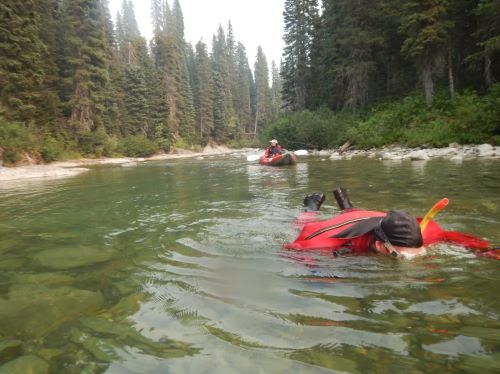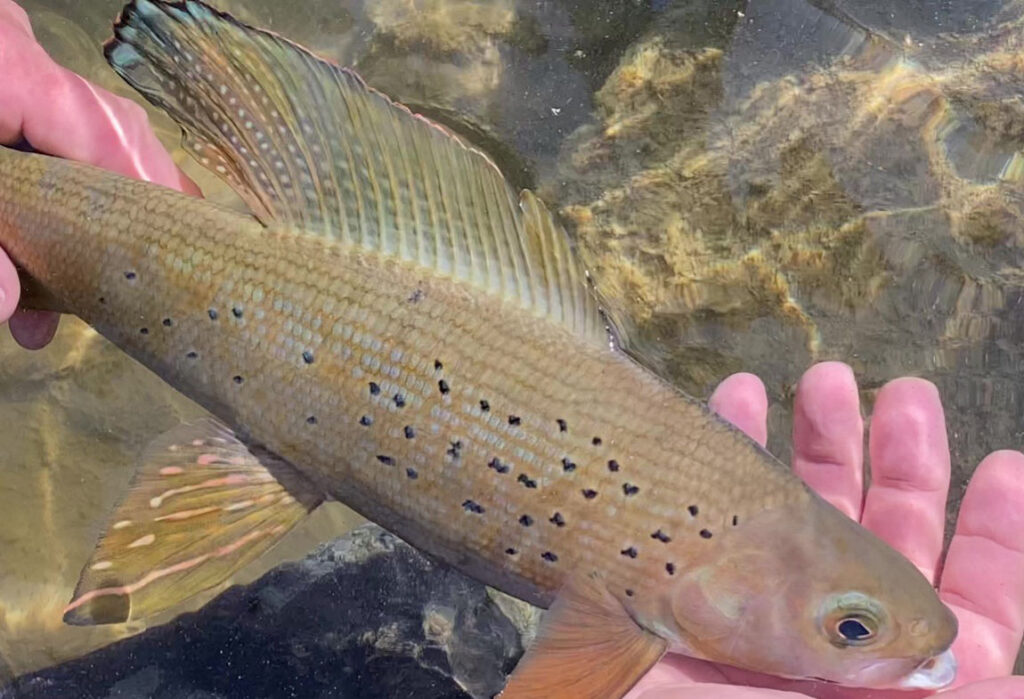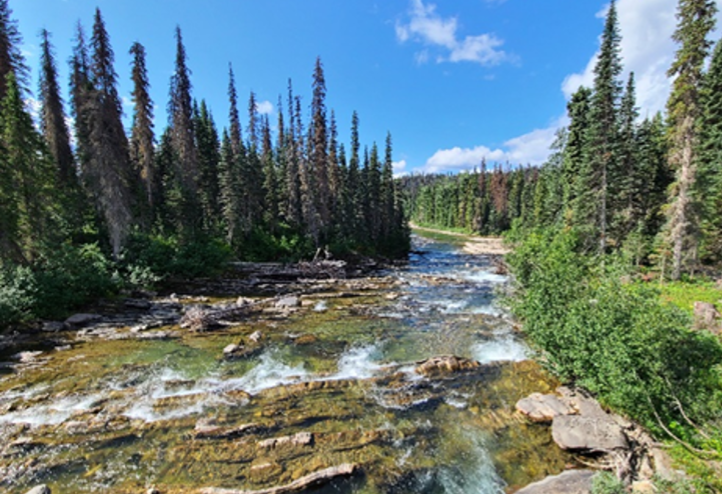Blog originally published May 2022.
This article follows up on a previous blog about Arctic grayling and a project that the Freshwater Fisheries Society of BC has funded for the past three years in support of a collaborative study on Arctic Grayling in the upper Peace River watershed.
Arctic grayling (Thymallus arcticus) is a member of the Salmonidae family of fishes, and related to salmon and trout. This species may not be as well known as other Pacific members of this family, given its comparatively small size and restricted distribution (occurring mainly in northern regions for B.C.). However, those familiar with Arctic grayling will likely agree it is outstanding for its attractive appearance, as well as hunger for virtually anything resembling prey (like a dry fly).


Grayling in the upper Peace
The Arctic grayling in the upper Peace River watershed were significantly impacted when the W.A.C. Bennett Dam was constructed on the river in the 1960s. The dam flooded preferred river habitats, preventing grayling from accessing key areas for feeding, spawning, rearing, and overwintering. The habitat alterations resulted in permanent, major reductions to Arctic grayling numbers and distribution. Grayling appear to be isolated to upper sections of only eight large tributaries of the upper Peace watershed, including the Parsnip River.
More recent and ongoing resource extraction and land development activities (like road construction, forestry, and pipelines) in affected watersheds put these fish at further risk. Arctic grayling populations in the Parsnip drainage are of interest to provincial fisheries biologists, local First Nations, and the local angling community. Grayling populations in the upper Peace watershed can never return to pre-dam abundance, but appropriate protection measures can ensure that remaining populations remain strong and can continue to provide excellent angling.
Assessing Parsnip River grayling abundance
In 2018, provincial biologists, in partnership with John Hagen and Associates and the BC Hydro Fish and Wildlife Compensation Program for the Peace Region, initiated a multi-year project to assess the long-term trend in abundance of Arctic grayling in the Anzac and Table rivers, and to estimate the fish’s distribution in six additional, previously unsurveyed rivers and creeks. These streams are all key tributaries of the Parsnip River. Long-term monitoring sites had been established for the Table and Anzac rivers, but assessments had not been conducted for over 10 years. Given their proximity to Prince George, these rivers see fair levels of angling activity. In addition, there is increased forestry due to recent spruce beetle outbreaks, and a gas pipeline development is underway in the Anzac watershed.
Key questions
Concerned that these changes may have further reduced numbers of Arctic grayling, the biologists were especially interested in these key questions:
- How does current abundance of Arctic grayling compare to previous levels from 1995 to 2007?
- Are current fishing regulations adequate to protect Arctic grayling from overharvesting and fishing-related death? Anglers should note that in the Omineca region, there is a spring closure of all streams to fishing from April 1 to June 30 each year (see tables for exceptions). Fishing for Arctic grayling is also catch-and-release only.
- Where are critical summer rearing habitats for Arctic grayling, and should these receive stronger protection?
Since the streams of interest have highly transparent waters, especially during lower flows in summer and fall, snorkel surveys to count fish are possible. While seemingly simple in concept, these snorkel surveys are logistically challenging given the remote locations involved – along with daunting rapids in some sections. To safely deliver the counts, each team of two biologists is accompanied by a safety boat.
An additional new technology, environmental DNA (eDNA), was also applied to support the more traditional snorkelling method of counting fish. Specifically, water samples were collected at key sites and, based on DNA found in the water, tested for fish species present. This DNA comes from fish mucous, sloughed-off skin and scales, and mortalities.


Results so far
The study will be completed in 2022. Results so far suggest that Arctic grayling have actually increased in numbers over the 1995-2021 period in the Anzac and Table rivers. This is good news! Notably, increases indicate that these habitats remain productive for Arctic grayling, and that the catch-and-release angling regulations now in place are effective in maintaining a sustainable recreational fishery.
For the previously unsurveyed streams, the combination of snorkelling and eDNA sampling has identified that critical summer rearing habitats for Arctic grayling exist in two rivers, but that populations here are smaller and more vulnerable than in the Anzac and Table rivers. Arctic grayling are also present in three of the other streams, but in very low densities.
Importantly, the new habitat information can now be used to identify and prioritize areas for habitat protection (e.g., using the Province’s Fisheries Sensitive Watershed designations). A collaboration with researchers at the University of Northern British Columbia will ensure that snorkel counts reflect accurate estimates of abundance.
River Guardians on the Parsnip
Going into 2022, the Freshwater Fisheries Society of BC is now funding a new River Guardian initiative in the Parsnip watershed. This program will put a fisheries presence on key tributaries to the Parsnip River to collect angling-related information, including use and compliance. The program will also support streamside outreach with anglers. The River Guardian data will be used in combination with the fish data to ensure that the regulations continue to support both the conservation needs for native species (especially Arctic grayling and bull trout) and good angling.
This blog series has been established as a way to inform freshwater anglers in B.C. about projects, such as this one, that their angling licence dollars support. In 2015, the Freshwater Fisheries Society of BC began receiving 100% (up from 70%) of all freshwater angling licence fees. With this additional funding, the Society committed to broadening the scope of its activities to include joint initiatives with the Provincial Government to support projects that benefit freshwater recreational fishing around B.C.
Authors: Sue Pollard, with contributions from John Hagen and Dr. Nikolaus Gantner.
